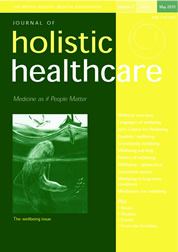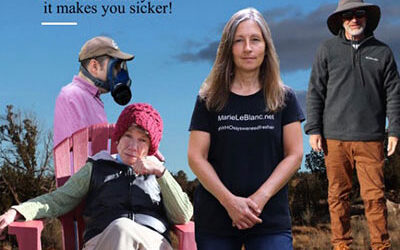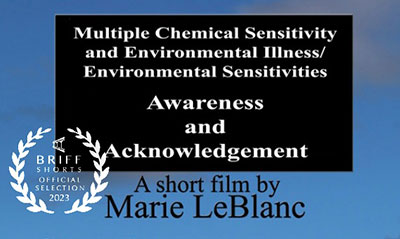 Ashok Gupta has announced the publication of the Clinical Audit Study this month on Gupta Amygdala Retraining™ treatments for ME/CFS, Fibromyalgia and MCS. His hope is that the positive initial results shown in this paper will stimulate funding for further research into the treatment. For those interested in the content of his program, this paper describes the exercises in more depth than previously published.
Ashok Gupta has announced the publication of the Clinical Audit Study this month on Gupta Amygdala Retraining™ treatments for ME/CFS, Fibromyalgia and MCS. His hope is that the positive initial results shown in this paper will stimulate funding for further research into the treatment. For those interested in the content of his program, this paper describes the exercises in more depth than previously published.
The PDF version of the published paper with diagrams can be downloaded here: Can amygdala retraining techniques improve the wellbeing of patients with chronic fatigue syndrome?
Journal of Holistic Healthcare Volume 7 Issue 2 P12-15 September 2010
CAN AMYGDALA RETRAINING TECHNIQUES IMPROVE THE WELLBEING OF PATIENTS WITH CHRONIC FATIGUE SYNDROME: A CLINICAL AUDIT OF SUBJECTIVE OUTCOMES IN A SMALL SAMPLE
Ashok Gupta MA(Cantab), MSc
Director, Harley Street Solutions
INTRODUCTION
The clinical audit to assess the effects of amygdala retraining techniques (ART) on patients with chronic fatigue syndrome (CFS), studied 33 patients (average age 37.8, male-female ratio of 1:2) with a confirmed diagnosis of CFS based on international criteria. They were recruited for one-year. Participants consented to take part in the audit, and the techniques were taught in detail to them. Initial self-assessments of functional abilities were taken at the start and one year after treatment.
Results: 93% of participants reported improvement. Two thirds of participants (67%) made considerable recoveries reaching ‘full functioning’ (80-100% of pre-illness levels). Six participants dropped out of the survey.
Conclusions: The clinical audit revealed higher rates of improvement in comparison to the natural remission rate in other intervention studies. Further randomised controlled studies are recommended to test the efficacy of ART.
BACKGROUND
Chronic fatigue syndrome is estimated to affect around 250,000 people in the UK. The clinical audit describes a pilot programme of a previously unpublished set of therapies known as amygdala retraining techniques (ART). This holistic set of treatments is underpinned by a medical hypothesis published in 20021 which implicates neurological trauma in the amygdala as the primary cause of CFS. This clinical audit was designed as a preliminary assessment of the effects of ART, and to prompt further research into its methods.
Amygdala retraining therapy is based on my novel hypothesis for the causes of CFS. I have suggested that following a ‘traumatic event involving acute psychological stress (possibly combined with other dysregulating factors such as a viral infection or other chemical or physiological stressors), the amygdala may – through a conditioning process – become chronically sensitised to signals arising from the body. These signals from the viscera (perhaps triggered by physiological, chemical or dietary stressors) become conditioning stimuli. The insular cortex may be involved in the process, as it interprets the emotional meaning of the symptoms, and passes that representation on to the amygdala. The conditioned response which is driven by the amygdala through its connections to various brain pathways including the hypothalamus, provokes a chronic over-activation of the sympathetic nervous system (SNS).
Certain neurologists conceptualise the neurological basis of conditioned responses as a network of neurones that create a specific output from a specific input. In these terms, it is such conditioning that produces the CFS vicious circle, which is triggered by an unconscious negative reaction to disturbing symptoms which in turn produces a state of chronic sympathetic over-activation. Eventually this may provoke sympathetic and immune dysfunction, as well as mental and physical exhaustion, and a host of distressing symptoms with secondary complications. However, because such symptoms are perceived as the sort of threat the insular cortex, amygdala and its associated limbic structures monitor and respond to, an amplifying feedback loop is likely to ensue. In effect, the amygdala having first become conditioned to hypervigilance to threat, upregulates the SNS, thereby producing bodily signals which drive rising levels of alarm, further increasing hypervigilance.
It is hypothesised that recovery from CFS might involve the development of neural pathways from the medial prefrontal cortex to the amygdala, which can control the amygdala’s over-sensitivity. This hypothesis was based on evidence from the work of Professor Joseph Ledoux, whose animal experiments over the past two decades linked the amygdala function to the monitoring of threat, and emotional responses including fear.2 This has become a generally accepted neurological model for these responses. Ledoux’s work emphasises the part played by external stimuli, for example electric shocks administered to rats. My 2002 paper1 emphasises that conditioned fear reactions could just as easily occur in response to internal stimuli, ie symptoms in the body. Ledoux was also able to link the extinction of these fear responses to neural pathways from the medial prefrontal cortex to the amygdala that potentially reduce the amygdala’s fear provoking over-sensitivity. If this neurological conditioning of the amygdala also occurs in CFS, the vicious circle described previously is likely to continue until this extinction occurs and the amygdala’s reactions are subdued.
Quirk et al3 in their work on the neurobiology of extinction processes, state that ‘extinction is new learning, rather than erasure of conditioning’. This implies that rather than erasing the original fear-conditioning pathways from the amygdala to the cortex, a new neuronal pathway has projected from the medial prefrontal cortex back to the amygdala to control it. ART aims, through a variety of techniques, to encourage this extinction process by the developing the so-called ‘safety neurone’. These techniques for down-regulating the amygdala’s reactions to bodily symptoms were developed over many years of working in a private clinic, during which at least 200 patients were treated.
It has to be emphasised that the neurobiological basis of the ART amygdala model as applied to CFS is currently difficult to test, and there is as yet no proof that the therapies developed are actually targeting this underlying neurological process. At this stage, both the hypothesis and treatments are work in progress, and only further research will establish the underlying mechanisms by which they might work. Real-time functional brain scanning before and after treatment, for instance, would be a useful avenue for future research. There are, however, some interesting parallels between the possible neurobiology of recovery from CFS, and extinction processes of fear responses in other conditions, most notably post traumatic stress disorder (PTSD). In PTSD, Milad et al,4 conducted a review of human studies which indicated that ‘PTSD is characterized by failure of the mPFC (medial prefrontal cortex) to sufficiently inhibit the amygdala’, and that ‘prefrontal areas homologous to those critical for extinction in rats are structurally and functionally deficient in patients with PTSD’. In CFS, there have also been studies which have found abnormalities in the prefrontal cortex. Okada et al5 reported an average 11.8% reduction in grey-matter volume in the bilateral prefrontal cortex in patients with CFS compared to healthy controls, a volume reduction which paralleled the severity of the fatigue of the patients. Furthermore, de Lange et al6 reported that ‘there is a significant increase in pre-frontal grey matter volume as a result of CBT in CFS patients’, and that the degree of success of CBT outcome was related to the degree of recovery in grey-matter volume in the lateral prefrontal cortex’. Once again, these parallels do not in themselves prove the connection between the amygdala and CFS, but they do tentatively support the hypothesis that CFS may ultimately be a brain disorder, where the function or structure of the prefrontal cortex is affected such that its ability to control the amygdala’s expression may be compromised.
The amygdala retraining techniques have been specifically designed to attempt to create a hypothesised ‘safety neurone’ from the cortex to the amygdala, by inducing a relaxation response each time the conscious mind is alerted to a symptom. I observed in my 2002 paper that patients may find it difficult to ‘take their minds off their bodies’, possibly because the amygdala is constantly arresting conscious attention due to its conditioning. Amygdala retraining techniques involve repeatedly interrupting the signals from the amygdala using a variety of techniques tailored to each patient. The patient is taught to recognise a fearful internal response to symptoms, and then to act on these feelings in a way which dramatically interrupts that anxiety or fear. At the end of the process, a relaxation signal is hypothesised to be sent to the amygdala using a form of NLP visualisation called an ‘anchor for health’. It could be hypothesised that this final relaxation response aims to create and strengthen the ‘safety neurone’ from the cortex to the amygdala.
One of the meditative techniques called ‘soften and flow’, is designed to deliberately calm the mind’s responses to symptoms through gentle awareness of symptoms in a meditative state. Anecdotally, patients report feeling more relaxed about their symptoms following these exercises. Lazar et al7 found ‘brain regions associated with attention, interoception and sensory processing were thicker in meditation participants than matched controls, including the prefrontal cortex and right anterior insula’. As before, this neurobiological finding allows tentative links to be made between the structure and function of the prefrontal cortex, and one of the amygdala retraining techniques.
The breathing technique used is called ‘alternate nostril breathing’, derived from yogic breathing practices. Another technique is a basic meditation where a patient is asked to focus on their pattern of breathing.
METHOD
The participants were recruited from CFS patient support groups in the UK. Advertisements were placed on support group websites, offering free treatment using a new experimental set of therapies, based on a new hypothesis. The participants were all asked to confirm that they had been diagnosed with CFS by a doctor who had excluded other possible causes through biomedical tests. They were also asked to confirm the presence of symptoms against the 1994 CDC international criteria for CFS.
The average age of the participants was 37.8 years (SD+/- 10) years, and the average number of years of suffering from the condition was 10.5 [SD +/- 9] years. The range of duration of the illness was from 2 to 40 years, and two thirds (67%) of participants were female.
Each participant was asked to state initially what percent of normal physical activity levels and functional abilities they were currently capable of. They then received treatment over the following six months consisting of a single face-to-face session with the author lasting 2.5 hours in which the techniques of ART were explained and taught. Participants were followed up weekly or fortnightly by telephone to check that they were complying, and to encourage correct use of the techniques. The ART techniques, holistic dietary, lifestyle, stress management, and self awareness treatments designed to work together to enhance the overall process were tailored to each participant, though they were applied equally to all participants within the programme. The stress tools and techniques took a minimum of 30 minutes a day in one sitting (meditation, ‘soften and flow’, and alternate nostril breathing), along with some short NLP-based 30-second tools used throughout the day, as and when required. Compliance varied amongst the participants. However, it was known that at least three of the participants were undertaking other treatments concurrently, and it is quite possible that others may have been. Undoubtedly this unknown variable will have been a confounding factor.
The participants were assessed over a year after the treatment using a simple qualitative self-assessment questionnaire which had been tried out on three participants to test its sensitivity. The questionnaire noted the participant’s assessment of functional ability (out of 100%), and information on improvements in levels of physical, mental and emotional functioning. Finally participants were asked to comment on their plans for the future.
RESULTS
Out of the total 33 participants, 27 participants completed the programme. Comparing the percentage self-assessment score out of 100 for each participant, 93% of participants (25 out of 27) reported improvements in functioning levels. Pre-treatment, the mean functioning score was 41.5% (+/- 16.0) which improved to a mean score of 77.0% (+/- 27.6) post-treatment. Two thirds of participants (18 out of 27) made considerable recoveries reaching ‘full functioning’, where full functioning is defined at being 80-100% of pre-illness levels (pre-treatment 47.9% +/- 13.9, post-treatment 94.2% +/- 4.7).
These participants stated that they did not feel that they were suffering from CFS any more, and instead that they were in a transition phase from being ill to adjusting back into normal life. Out of 27 participants, 15 reported a 90-100% recovery (pretreatment 47.8% +/- 14.4, post-treatment 94.8% +/- 4.2). A minority of participants (two) noticed no significant physical improvement, although there were self-reported improvements in psychological wellbeing in both of these participants.
The six participants who dropped out did so within the first month. They stated that their reasons for leaving included having too much going on in their lives to commit to practising the techniques, or prioritising another treatment. The 18 (67%) participants who reached ‘full functioning’ were very pleased with the progress they had made, and some were surprised at the speed with which occurred. During the recovery process, many participants commented that they had ups and downs, though we found no obvious overall pattern to the recovery process. They commented that persistence with the techniques was essential. Most participants at the 80-100% functioning mark stated that they did not class themselves as having CFS anymore, but rather were simply adjusting to normal life again. Many were looking for part-time or full-time work, or indeed had re-entered the workplace already. Out of the 18 participants who had reached full functioning, 13 have already begun full-time work.
The qualitative data gathered could be summarised into key themes:
• Physically, participants felt that they were able to do much more without the post-exertional malaise that usually accompanies the condition, with many participants able to engage in a moderate workout at the gym.
• Mentally, with respect to cognitive function, better concentration and memory was highlighted as a key benefit, as well as no ‘brain fog’.
• Emotionally, the vast majority of participants regarded themselves as much less anxious, and coping skills and strategies were very much improved. When asked about the future, participants who had reached full functioning spoke of returning to full-time work (if they not done so already). Others who had not reached this level of functioning were generally optimistic that as long as they kept up the techniques, they would hope to see further progress.
DISCUSSION
The findings of this survey indicate that improvements in health were achieved with the vast majority of participants (93%). Furthermore, for a significant majority of participants (67%), they achieved 80-100% functioning of pre-illness levels. In comparison, standard placebo group improvement rates in intervention studies are in the region of 6-20%.8
A recent comparative study by Jason et al (2007)8 reported significant improvement rates of 28% for cognitive therapy, 20% for cognitive behaviour therapy, 16% for anaerobic activity, and 12% for relaxation therapy. However it was noted in Jason’s study that the vast majority of patients still continued to be diagnosed with CFS. Research comparing ART with cognitive behavioural therapy (CBT) would be useful.
One of the key challenges with the application of ART is its holistic nature. Each participant brought their own unique personal and lifestyle issues with them and therefore it was important for the therapist to personalise the combination of tools and techniques for that patient. My belief that better outcomes can be achieved using this approach than by using a standardised therapy would also need to be tested further in any future study.
As an initial clinical audit, there were methodological limitations, and a further randomised controlled study using standardised measures will need to be conducted to establish whether ART is in fact an effective treatment. Only then can further steps be taken to incorporate this individualised approach to treatments into primary and secondary care provision.
Limitations
No control group or placebo group was used, and future studies would need to incorporate this. No standardised tools were used, and randomised collection was not employed. Researcher bias, and the effects of researcher/practitioner enthusiasm, were significant confounding factors, as were participants’ possible use of concurrent therapies. Sample bias was significant in that those completing the programme may have shown more motivation and commitment.
CONCLUSION
The clinical audit of the ART approach suggested higher rates of improvement in comparison to the natural remission rate reported in other intervention studies. Further double-blind/randomised studies are recommended to test the efficacy of ART.
ACKNOWLEDGEMENTS
Thank you to all the patients for participating. Thanks also goes to Dr Mohan Pawa for his contributions and advice, as well as Karen Goldman for her help with this paper.
REFERENCES
1Gupta A. Unconscious amygdalar fear conditioning in a subset of chronic fatigue syndrome patients. Medical Hypotheses 2002; 59 (6): pp727-735.
2Ledoux J. The emotional brain. London: Weidenfeld & Nicolson, 1998.
3Quirk GJ, Garcia R, González-Lima F. Prefrontal mechanisms in extinction of conditioned fear. Biol Psychiatry 2006; 60(4): pp337-43.
4Milad MR, Rauch SL, Pitman RK, Quirk GJ. Fear extinction in rats: implications for human brain imaging and anxiety disorders. Biol Psychol. 2006; 73(1): pp61-71.
5Okada T, Tanaka M, Kuratsune H, Watanabe Y, Sadato N. (2004). Mechanisms underlying fatigue: a voxel-based morphometric study of chronic fatigue syndrome. BMC Neurol 2004; 4 (1): p14.
6de Lange FP, Koers A, Kalkman JS, Bleijenberg G, Hagoort P, van de Meer JW, Toni I. Increase in prefrontal cortical volume following cognitive behavioural therapy in patients with chronic fatigue syndrome. Brain 2008; 131 (8): pp2172-2180.
7Lazar SW, Kerr CE, Wasserman RH, Gray JR, Greve DN, Treadway MT, McGarvey M, Quinn BT, Dusek JA, Benson H, Rauch SL, Moore CI, Fischl B. Meditation experience is associated with increased cortical thickness. Neuroreport 2005; 16: pp1893-7.
8Jason LA, Torres-Harding S, Friedberg F, Corradi K, Njoku MG, Donalek J, Reynolds N, Brown M, Weitner BB, Rademaker A & Morris Papernik. Non-pharmacologic interventions for CFS: A randomized trial. Journal of Clinical Psychology in Medical Settings 2007; 14 (4): pp 275-296.
Further Information and Links:
– Further information on the Amygdala Retraining Programme: guptaprogram.com*
– Ashok Gupta will be conducting a workshop on his techniques on the 15th-16th of October in London, details here: guptaprogramme.com/workshop.asp
– To view Ashok’s Draft Medical Paper on The Amygdala Hypothesis and XMRV Virus Findings, click here: How XMRV Retrovirus Findings May Fit With The Amygdala Hyperarousal Model for ME/CFS
– The PDF version of the published paper can be downloaded here: guptaprogramme.com/Amygdala_Retraining_JHH_Sept_2010.pdf
*As of January 25, 2010, Planet Thrive is participating in an affiliate program for the Gupta Amygdala Retraining Programme™ after observing over 30 members of the Planet Thrive Gupta Support Group, who reported many benefits over several months time. As of September 21, 2010, there are 65 members in the support group who continue to report positive benefits from the program.









Please advise what medical qualifications and training Ashok Gupta has.